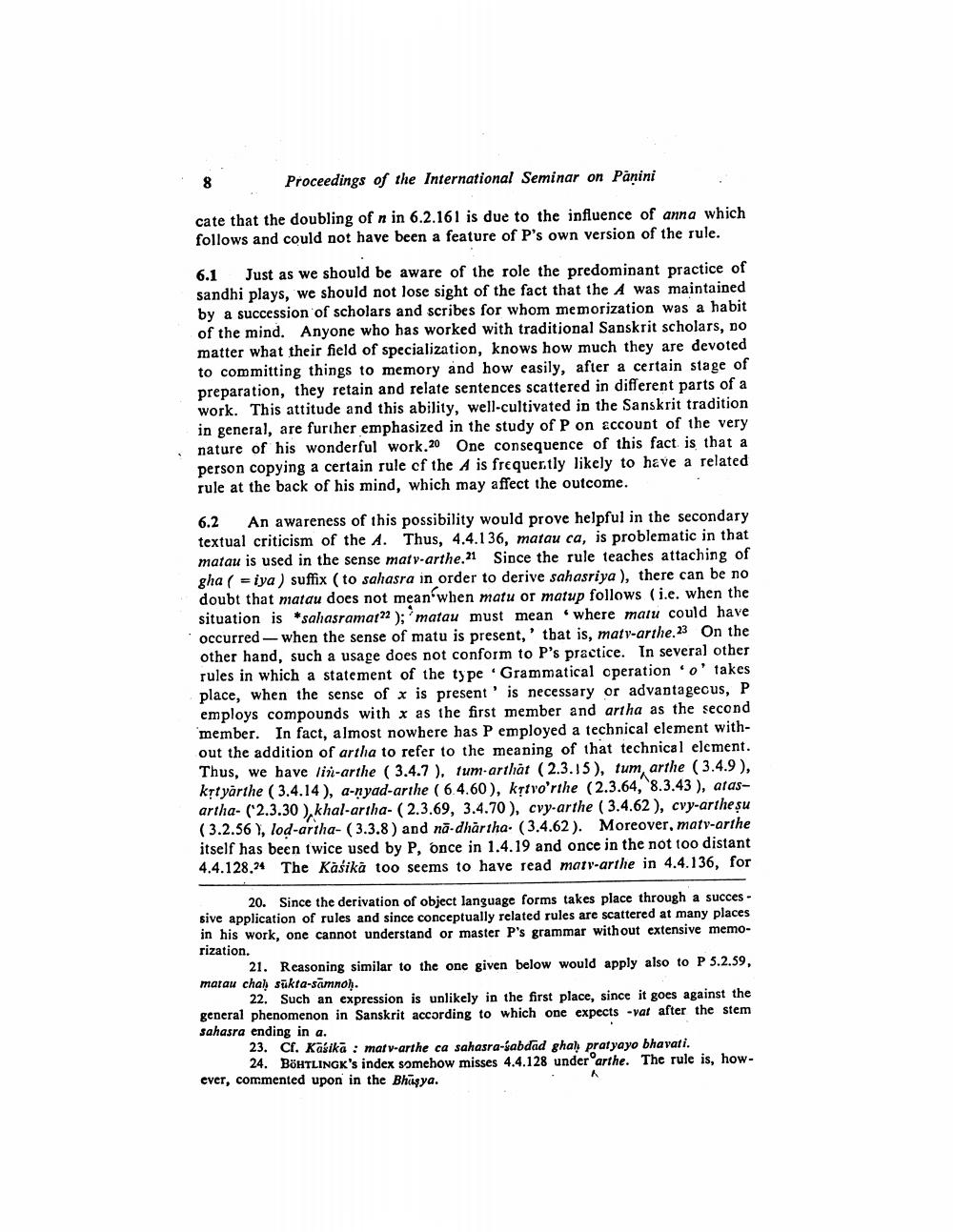________________
8
Proceedings of the International Seminar on Panini
cate that the doubling of n in 6.2.161 is due to the influence of anna which follows and could not have been a feature of P's own version of the rule.
6.1 Just as we should be aware of the role the predominant practice of sandhi plays, we should not lose sight of the fact that the A was maintained by a succession of scholars and scribes for whom memorization was a habit of the mind. Anyone who has worked with traditional Sanskrit scholars, no matter what their field of specialization, knows how much they are devoted to committing things to memory and how easily, after a certain stage of preparation, they retain and relate sentences scattered in different parts of a work. This attitude and this ability, well-cultivated in the Sanskrit tradition in general, are further emphasized in the study of P on account of the very nature of his wonderful work.20 One consequence of this fact is that a person copying a certain rule of the A is frequently likely to have a related rule at the back of his mind, which may affect the outcome.
6.2 An awareness of this possibility would prove helpful in the secondary textual criticism of the A. Thus, 4.4.136, matau ca, is problematic in that matau is used in the sense matv-arthe. 21 Since the rule teaches attaching of gha ( = iya ) suffix (to sahasra in order to derive sahasriya ), there can be no doubt that matau does not mean when matu or matup follows (i.e. when the situation is *sahasramar22 ); 'matau must meanwhere malu could have occurred when the sense of matu is present,' that is, matv-arthe 23 On the other hand, such a usage does not conform to P's practice. In several other rules in which a statement of the type Grammatical operation o' takes place, when the sense of x is present' is necessary or advantagecus, P employs compounds with x as the first member and artha as the second member. In fact, almost nowhere has P employed a technical element without the addition of artha to refer to the meaning of that technical element. Thus, we have lin-arthe ( 3.4.7). tum-arthåt (2.3.15), tum, arthe (3.4.9), krtyarthe ( 3.4.14), a-nyad-arthe ( 6.4.60), kȚtvo'rthe (2.3.64, 8.3.43 ), atasartha- (2.3.30), khal-artha- (2.3.69, 3.4.70), cvy-arthe ( 3.4.62 ), cvy-arthe su ( 3.2.56), lod-artha- (3.3.8) and nā-dhartha. (3.4.62). Moreover, matv-arthe itself has been twice used by P, once in 1.4.19 and once in the not too distant 4.4.128.24 The Kašika too seems to have read matv-arthe in 4.4.136, for
20. Since the derivation of object language forms takes place through a succes - sive application of rules and since conceptually related rules are scattered at many places in his work, one cannot understand or master P's grammar without extensive memorization.
21. Reasoning similar to the one given below would apply also to P 5.2.59, matau chah sukra-samnoh.
22. Such an expression is unlikely in the first place, since it goes against the general phenomenon in Sanskrit according to which one expects -vat after the stem sahasra ending in a.
23. Cf. Käsikā : matv-arthe ca sahasra-sabdad ghal pratyayo bhavati.
24. BÖHTLINGK's index somehow misses 4.4.128 under arthe. The rule is, however, commented upon in the Bhagya.




